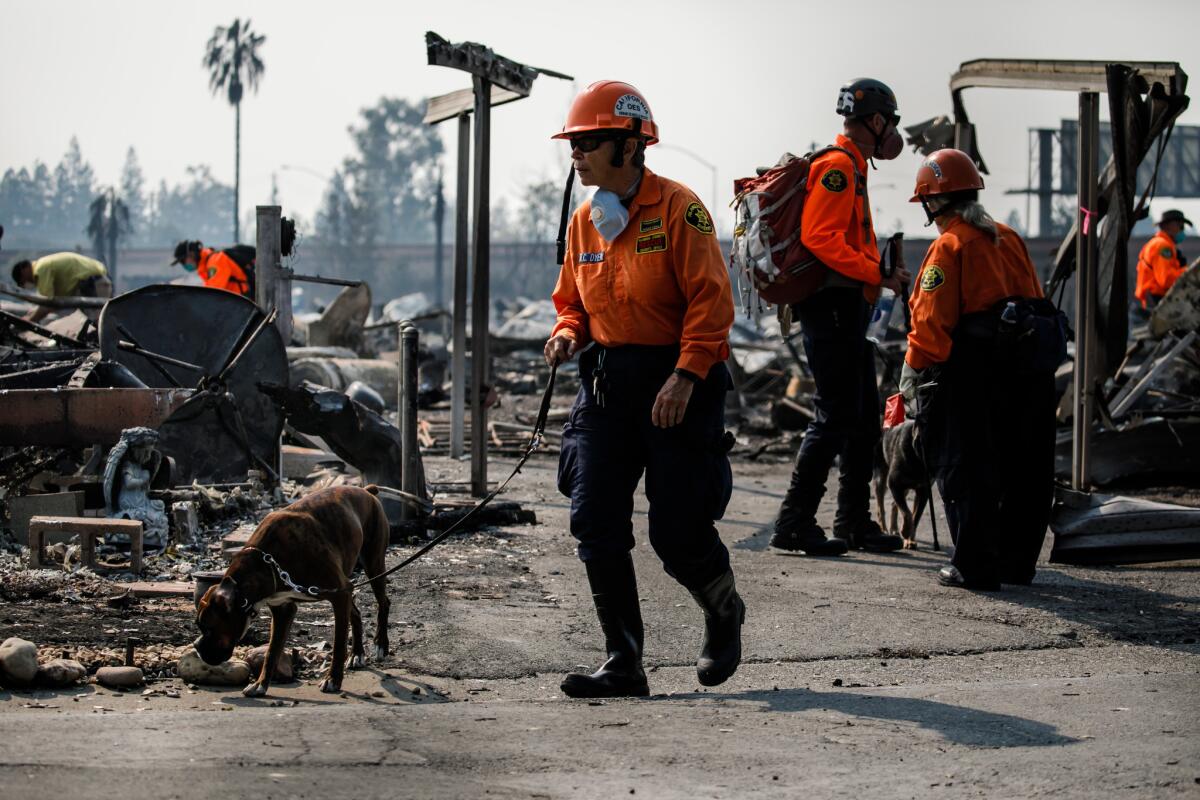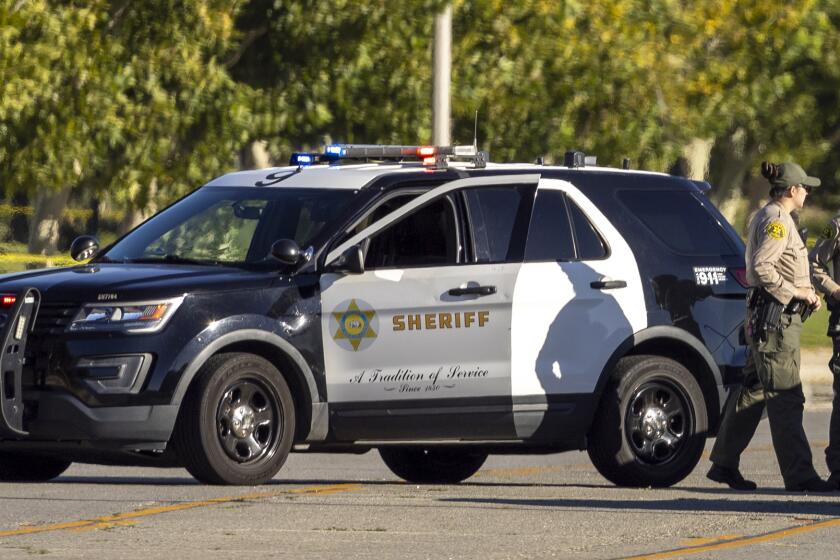Many killed in California firestorms were in their 70s and 80s

- Share via
Reporting from SANTA ROSA, Calif. — LeRoy and Donna Halbur moved into their hillside home on Angela Drive in Santa Rosa almost four decades ago.
The couple celebrated their 80th birthdays and 50th wedding anniversary there in August, eating good food and sipping wine with their family in the backyard. Their sons, Tim and David, played songs from the old Bing Crosby record they loved.
Then, on Sunday night, a firestorm swept through their neighborhood. Searchers later found the couple dead. LeRoy was in the driveway, his son said. Donna was in the car parked in the garage.
As fires continue to rage through the communities of Northern California, family members are discovering a grim pattern to the devastation.
Among the at least 34 people killed by the blazes, more than a dozen have been identified, most of whom were in their 70s and 80s.
The wine country firestorms are just the latest to show the special vulnerabilities the elderly face when flames sweep into neighborhoods with little notice, leaving some simply unable to get out in time.
Officials said it is already clear the elderly will be disproportionally represented among the victims this time.
“The bulk of them are in their 70s and 80s, so that is the commonality,” Sonoma County Sheriff Rob Giordano said.
Vice President Mike Pence drew attention to the situation in comments he made earlier this week in Sacramento.
The loss of life is heartbreaking, said Pence, “to think that many of the fallen represent our most vulnerable, in some cases senior citizens who simply were not able to escape the flames that overcame their homes.”
Altogether, the 15 fires across wine country have burned more than 212,000 acres, 5,700 structures, along with the nearly three dozen deaths. Officials expect the death toll to rise as search efforts continue.
Santa Rosa was the hardest-hit community, with 2,834 homes and 400,000 square feet of commercial space destroyed. Santa Rosa Mayor Chris Coursey estimated the flames had caused $1.2 billion worth of damage and destroyed 5% of the city’s housing stock.
Rescuers are still sifting through the flattened neighborhoods, looking for victims. They found the body of retired real estate agent Carol Collins Swasey, 76, inside her home in Santa Rosa’s devastated Coffey Park neighborhood. Her husband, Jim, was out of town when the fire hit. He couldn’t get ahold of her and called authorities.
According to Sonoma County spokesman Scott Alonso, the efforts of police officers on Sunday night — going door-to-door, alerting residents to evacuate — was prompted in part by the limitations faced by the elderly and disabled.
Constrained by declining health, dependent on others for transportation and living in rural areas with limited cellphone service, this vulnerable population has been overlooked in the past.
The lesson came to light in 2007 in the aftermath of two San Diego wildfires.
Disability rights advocates had been pressing for better disaster planning when it was learned that the deaf community had not received emergency notifications, that individuals with mobility issues could not be evacuated with their power wheelchairs and that shelters had trouble accommodating those with medical conditions.
In the aftermath, the state established the Office of Access and Functional Needs.
Its efforts at reform, however, were not enough when the fast-moving Valley fire in 2015 ripped through Lake County, north of Napa, and took the lives of a 72-year-old woman with multiple sclerosis trapped in her home, and three men over the age of 65, two of whom miscalculated the fire and decided not to evacuate.
Days earlier, the Butte fire in Amador County didn’t spread as quickly, but its casualties included a one-legged 65-year-old man who remained to protect his property and an 82-year-old man, who a friend said had become depressed and increasingly immobile.
Two years later, the tragedy seems to be repeating itself.
LeRoy and Donna Halbur were born four days and about 200 miles apart in Iowa. He served in the U.S. Army, then went to college on the GI Bill and became an accountant. She was a nun who left the order to earn a college degree of her own, later working with children as a reading specialist.
They moved to California in part because of her allergies, initially setting their sights on La Jolla, said their son, Tim. But when LeRoy got a job in Santa Rosa, the couple settled there.
LeRoy was devoted to the community — a reflection of his Catholic faith, Tim said. He traded vegetables from his garden with neighbors. He served as an usher at the couple’s church and helped start the Sonoma County branch of St. Vincent de Paul, a Catholic charity. He delivered food to those in need each week, his son said, loading up donations just days before his death.
“He didn’t want any credit,” Tim said. “He just served.”
On Sunday night, when the Altas fire ripped through Napa County, Sara and Charles Rippey were at home with their caretaker, Maria Sandovar. At 98, Sara had a stroke five years ago, and Charles, 100, was always at her side, according to their son, who visited two or three times a week.
That night, strong winds made the lights flicker, and when Sandovar looked out the back window, she saw that the home’s fence was on fire.
She ran to lift Sara out of bed and into her wheelchair. Charles was in the hallway.
“What’s going on?” Sandovar remembers him asking.
In a matter of minutes, black smoke had filled the house.
Sandovar called out, but there was no response. Without electricity, she could not open the garage door to get Sara out.
The caretaker jumped over a collapsed fence and escaped, just before the roof crashed down. Neither Sara nor Charles survived.
kate.mather@latimes.com
alene.tchekmedyian@latimes.com
laura.nelson@latimes.com
esmeralda.bermudez@latimes.com
Nelson reported from Santa Rosa. Times staff writer Paige St. John in Napa County, Nina Agrawal in Santa Rosa and Thomas Curwen, Javier Panzar, Benjamin Oreskes, Sonali Kohli and Dakota Smith in Los Angeles contributed to this report.
More to Read
Sign up for Essential California
The most important California stories and recommendations in your inbox every morning.
You may occasionally receive promotional content from the Los Angeles Times.

















